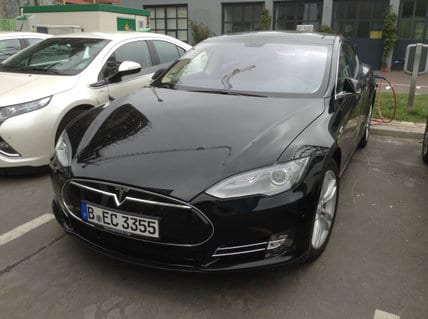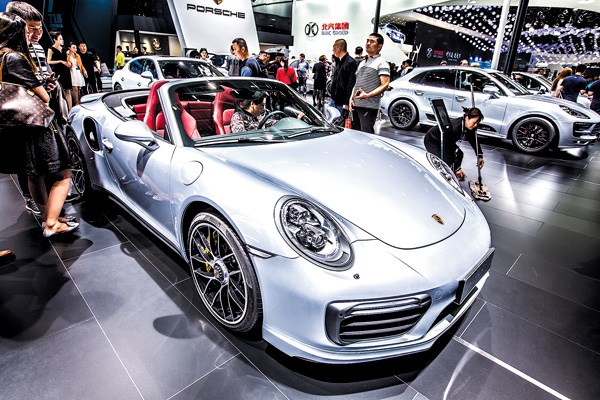
PEUGEOT Partner Tepee Electric
The new Peugeot Partner Tepee Electric unites the advantages of the Partner Tepee leisure activity vehicle, which have made it such a success since its launch, and the pleasure of driving an electric vehicle. It offers comfort for five passengers with a generous, modulable interior. Peugeot Partner Tepee Electric has been developed for the growing clientele that wants to reconcile electric mobility with a multiplicity of everyday activities, whether just personal or both personal and professional. Its certified range of 170 km matches the driving practices of the great majority of European motorists who drive a daily average of fewer than 60 km. Peugeot Partner Tepee Electric thus opens up electric vehicles to new possible uses: carpooling with five people or leisure activities for the family, for example, are now compatible with electric mobility.
The first worldwide launch of the Peugeot Partner Tepee Electric will be at the 2017 Geneva International Motor Show. It will go on the market in September.
The freedom of driving 100% electric The best kind of liveability and modularity
The new Peugeot Partner Tepee Electric features the liveability and practicality for which the Peugeot Partner Tepee leisure activity vehicle is known. With its modulability, five passengers fit comfortably inside, and transporting large objects is easy:
– 5 seats, with the possibility of removing the three seats in the second row to free up a flat floor;
– Boot volume among the best in the category, with up to 1,350 litres with five passengers and 3,000 litres with two passengers and the seats in the second row removed;
– Exclusive on the segment, the large tailgate and rear window can be opened to make it easy to load the boot in any conditions.
This remarkable modularity can be adapted to all kinds of activities. Taking children to school, carpooling to work, and transporting bicycles for a ride with family or friends are now all possible with this 100%-electric leisure vehicle.
Everyday practicality
For even more peace of mind and comfort during your trips, the new Peugeot Partner Tepee Electric offers features remotely controlled from a smartphone or tablet:
Programme the heat or air conditioning in the passenger compartment; See the battery charge; Estimate the duration of the recharge. The remote control of heat and air conditioning makes it possible to preset the temperature in the passenger compartment before getting in the vehicle. If it is programmed at least 30 minutes in advance, the driver will enjoy optimal thermal comfort. This exclusive feature will work whether the vehicle is charging or not:
When the vehicle is charging, the temperature preset does not affect the range; When it is not charging, the driver can simply indicate the battery charge level to preserve for the next trip. The new Peugeot Partner Tepee Electric offers a wide range of useful and effective equipment to guarantee safety and make both driving and life easier every day.
Comfortable and ergonomic, the passenger compartment provides 78 litres of open or closed storage space.
The cruise control, the direct tyre pressure monitor, the electronic stability control (ESC) paired with the hill-start assist, the manual climate control, the radio and CD and MP3 players, the two sliding side doors, and the height-adjustable driver's seat are available as standard.
The reversing camera, available as an option, uses the large colour screen to simplify parking every day. To make low-speed manoeuvring even easier, the rear parking assistance available as standard on the second level can be complemented by front parking assistance.
In touch with the present day, the new Peugeot Partner Tepee Electric features a perfectly integrated large, seven-inch colour touch screen in the middle of the dashboard, always within view and arm's reach. Available as standard for the second level, it allows the drive to access various features: the on-board computer, AM/FM radio, digital DAB (Digital Audio Broadcasting) as an option, reading of music files on mobile devices, hands-free telephone, and navigation.
It also includes the best of on-board connectivity: Bluetooth®, USB port, jack plug, and the MirrorScreen function. From a smartphone compatible with Mirrorlink® or Apple Carplay®, the MirrorScreen lets users duplicate the best of their mobile applications on the large touch screen in the vehicle, so they can safely and fully enjoy them.
Navigation, available as an option, includes speed limit and traffic information display.
Advantages of zero-emissions mobility
In addition to all its modularity and practicality, the new Peugeot Partner Tepee Electric offers specific advantages related to its electric power chain.
With this power chain, users can drive in regulated-emissions zones and during restricted-traffic times, without compromising practicality of use or the pleasure of driving.
More and more municipalities are encouraging the development of electric vehicles with advantages just for them, like free or discounted parking or reserved lanes. For professionals, electric vehicles are exempt from certain taxes, such as the Company Vehicle Tax (TVS) in France.
Its rapid recharge mode to 80% in 30 minutes, available as an option, provides drivers with more daily trips.
The new, 100%-electric version reduces environmental impact while offering a perfect solution for multiple everyday activities.
Less costly to run
The new Peugeot Partner Tepee Electric also provides worry-free maintenance at about 30% less than an internal combustion vehicle:
Its traction battery is guaranteed for eight years or 100,000 km, and its electric power chain is guaranteed for five years or 50,000 km, whichever comes first; Maintenance, every two years or 40,000 km after the first year, does not require oil, a belt, or liquid coolant. With no gearbox or clutch, there are fewer components to inspect. With the double energy recovery through deceleration and braking, the brakes are used less, and wear out less easily. Furthermore, the energy cost per kilometre of electric recharging is about four times less than that of fuel for an internal combustion vehicle[1].
100% electric driving pleasure
Designed based on the Peugeot Partner Tepee leisure activity vehicle with an internal combustion engine, the new Partner Tepee Electric borrows the electric power chain from the Peugeot Partner Electric van, tried and tested since 2013.
The electric motor—high-performing, compact, synchronous with permanent magnets, 49 kW (67 hp)/200 Nm—is located under the bonnet.
The two lithium-ion battery packs, with high energy density and a 22.5-kWh capacity, are located in the underframe at either side of the rear suspension. This location lowers the centre of gravity for dynamic driving and good manoeuvrability in the new Peugeot Partner Tepee Electric. It also preserves the liveability of the Partner Tepee, as well as its reference boot volume.
The electric motor, with instantly available torque, is paired with single speed constant ratio transmission. It offers dynamic, flexible driving as soon as it starts, all the way through every phase of acceleration. All without changing gears—or an automatic gearbox can be added.
As soon as the wheels begin to turn, the vehicle provides a peaceful driving experience free of noise and vibration from the electric power chain. In the quiet atmosphere of the new Peugeot Partner Tepee Electric, trips become less tiring and conversations easier.
To adapt to everyday needs, the Peugeot Partner Tepee Electric offers to battery charging modes:
a standard charge on a traditional domestic outlet (8-A or 10-A, depending on the country) or the secured Green Up charge (14-A). That means a full recharge (from an empty battery) takes eight and a half, 12 or 15 hours depending on outlet amperage. a rapid charge that meets the CHAdeMO[2] (95-A) standard recovers 80% of battery capacity in 30 minutes. The regular charging flap is located on the right front fender, while the rapid-charge outlet takes the place of the gas tank flap on the left rear fender.
Recommended service providers in the Peugeot network offer solutions for installing an outlet at an individual home or collective building, such as a business.
The new Peugeot Partner Tepee Electric has a 170-km range on the New European Driving Cycle, and brings together a set of features to optimize the range during real-life usage:
– The highly visible, combined energy consumption/regeneration indicator helps the driver constantly work to adopt low-energy driving;
– An auxiliary consumption gauge (heat and air-conditioning) fills out the driver information display. The on-board computer displays remaining range and mean consumption in kWh;
– The double energy recovery in the deceleration phase and the active braking phase converts kinetic energy into electric energy. Vehicle range in the driving phase is thus better preserved;
– 100% electric-origin heating offers fast heating in the passenger compartment. It also features an "Eco" setting to prevent overconsumption of electricity through the ventilation system to promote vehicle range.
Peugeot and the sustainable model
Peugeot is the only brand in the world to market a comprehensive sustainable mobility offering: electric-assist scooters and bikes and an electric motor-scooter, in addition to personal and utility cars.
With the Peugeot Partner Tepee Electric leisure activity vehicle the brand is further filling out its range of electric mobility products, which includes:
the Peugeot iOn urban saloon; the Peugeot Partner Electric van; the new Peugeot GenZe (Generation Zero emission)[3] electric motor-scooter; a range of electric-assist bicycles for every condition: road, hybrid, and mountain bikes, with new products including the 2017 eF01, the first electric-assist folding bike from Peugeot, and the Eu01, for riding at 45 km/h; the Peugeot e-Kick electric-assist scooter, from a partnership with MICRO. The multimodal e-Kick and eF01 feature ergonomic design from the Peugeot Design Lab, making them easier to use. Their transport, use, and storage have been optimized. They are two complementary mobility solutions for easily covering the last kilometres of your journey once you have parked your vehicle. A docking station lets users store them in the boot of any vehicle equipped with a 12-V outlet, such as the new Peugeot Partner Tepee Electric, and to recharge them whenever the vehicle is in operation. They can also be recharged at a home on a traditional outlet.
Today, Peugeot is responding to new urban mobility challenges at a time of increasingly limited access to city centres.
In line with its commitments for reducing the environmental impact of its end-of-life vehicles, PSA has joined with the SNAM, the European leader in high-voltage battery collection and recycling.
Signed within the framework of the PSA-SNAM partnership in place since 2012 in France, the end-of-2015 agreement guarantees the quality of collection and recycling of batteries from Group electric and hybrid vehicles in end-of-life, across its commercial network and production sites in Europe.
The SNAM obtains performances of 70% efficiency of recycled materials for electric vehicle Li-ion batteries and 84% for hybrid vehicle Ni-MH batteries. These rates lie well above the European regulation threshold of 50% materials recycling.
[1] Furthermore, 25% of electric vehicle users estimate they save up to 60% of monthly transport fees compared to driving a vehicle that uses conventional fuel, according to a European NewMotion study.
[2] *The CHAdeMO protocol is the first standard for rapid charging created in 2009. It belongs to three systems currently approved as international standards for rapid charging. The number of CHAdeMO-compatible rapid charging terminals in Europe rose from 2,755 in 2015 to 4,000 at the end of 2016, an increase of 45%, well above the world average of 35%. This trend is expected to continue in Europe, at a time when European Union member states are establishing objectives for recharging station roll-out, as demanded by the directive on alternative fuels. Source: AVERE (French national association for electric mobility development)
[3] A pioneer in electric mobility, the Peugeot Scooters brand is one of the first to have invested in the segment when it launched Scootelec in 1996, then E-Vivacity in 2011. In 2016, Peugeot Scooters presented the new version of the "Generation Zero Emission" scooter, developed in collaboration with Mahindra-Genze.
Source:
Peugeot Debuts New Partner Tepee Electric But Only Equipped With 22.5 kWh Battery





















